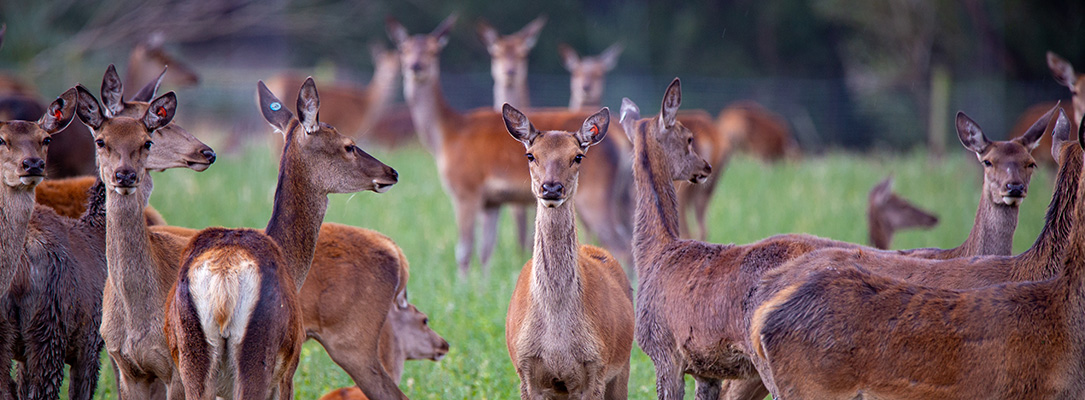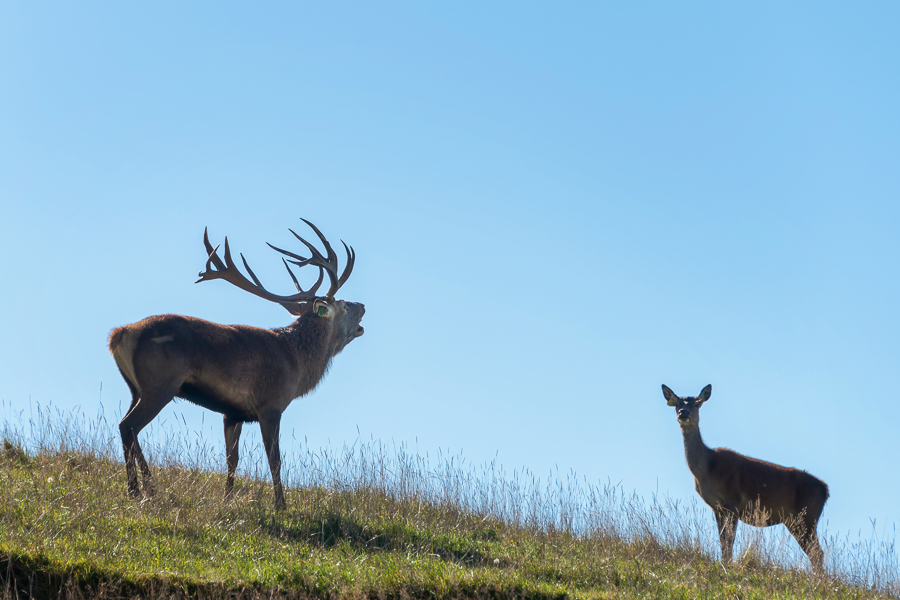
As the breeding season approaches, ensuring your herd is in peak condition is essential for successful mating and maximising the reproductive outcome and growing offspring well.
Proper management of both hinds and stags during this time can significantly impact fertility, conception rates, and the overall health of your animals.
Below, we outline key strategies that focus on feeding, trace elements, and preventing leptospirosis to help you prepare your herd for the mating season.
Both hinds and stags require high-quality nutrition leading into the mating period. Proper feeding ensures that they have the energy reserves needed for successful breeding and conception. Here is what you should focus on:
High-quality forage: Ensure that the herd has access to lush, high-quality pasture, which is rich in protein and energy. Forage may be supplemented if pasture quality declines, particularly in areas with adverse weather conditions.
Pre-breeding nutrition for hinds: Hinds should be in optimal body condition prior to the start of the rut. Target a condition score of 3.0 to 3.5 on a scale of 1 to 5. If necessary, supplement their diet with high-energy feeds or concentrates. It may pay to supplement the hinds (or the current fawns to reduce their drain on the dam) if the hinds need to gain BCS heading into the roar.
Stag nutrition: Stags also require a good pre-rut diet to maintain energy and body condition. However, be mindful not to overfeed stags, as excess weight can negatively affect their stamina and performance during the rut. Maintaining a body condition score of 3.5 to 4.0 is ideal for stags.
Trace elements play a crucial role in supporting fertility and overall health, especially as animals enter the breeding season. Key trace elements to focus on include:
Copper: Copper is vital for proper immune function and overall health. Deficiencies can lead to reduced fertility, poor growth, and compromised immune systems. Ensure that both hinds and stags receive adequate copper, either through mineral supplements or copper-infused feed.
Zinc: Zinc supports the immune system and reproductive health. It is especially important for sperm production in stags and for the overall well-being of hinds. Make sure the herd has access to a balanced mineral supplement that includes adequate zinc levels.
Selenium: Selenium is really important in all animals for immune system functioning, and there are very large parts of the country that have inadequate selenium. Talk to your vet about the best approach for supplementing.
There are a number of vets across the Vetlife clinics who have had training in how to collect liver biopsy samples from hinds and weaners. We highly recommend arranging for liver and blood samples to be taken to check the mineral status of your herd. Then, appropriate and adequate supplementation can be given to support the herd through what can be a challenging time for them.
Leptospirosis is a bacterial infection that can significantly affect both fertility and overall health in your deer herd. It is particularly important to protect both hinds and stags from this disease heading into the mating season.
Abortion in hinds: Infected hinds may experience early pregnancy loss, reducing overall breeding success. A Massey University study from the 2000s indicated a drop in weaning rate by 9% due to the presence of Lepto.
Transmission risks: The disease is spread through contact with urine from infected animals, contaminated water sources, and through environmental contamination, particularly in wet, marshy areas.
Vaccination: Vaccination is the most effective way to protect your herd. Make sure both hinds and stags are up to date with their leptospirosis vaccinations. Consult with your veterinarian to establish a vaccination schedule that aligns with the mating season.
Minimise risk of exposure: Avoid overcrowding animals near water sources that may be contaminated. Control access to wet areas and ensure that water supplies are clean and regularly monitored.
In addition to proper feeding, mineral supplementation, and disease prevention, minimising stress during the pre-rut and rut periods is essential. Stress can negatively impact fertility in both hinds and stags. Ensure that your animals are handled gently, have adequate space, and are not exposed to unnecessary stressors, such as overcrowding, and minimise exposure to extreme weather conditions by providing shelter from the elements.
Regular monitoring of the herd’s condition, both physically and behaviourally, can help you spot any early signs of stress, illness, or nutritional deficiencies. Timely intervention can prevent minor issues from becoming major problems during the critical breeding period.

The stag has only one job when it comes to the breeding herd, and that is to sire offspring. To perform at their best, stags need to have adequate body condition score, trace element status and be free of injuries, abnormalities and disease.
Stags will put on considerable weight over the spring and early summer period if they are fed well. As the days begin to lengthen from January onwards, testosterone levels rise, and this brings about some very impressive changes. Testes growth and sperm production begins, and mineralisation of velvet antler occurs which leads to the hardening and stripping of the antler we see in late February.
Before this reaches its peak, it is a good idea to do pre-mating checks for stags.
Generally the fertility of a stag is only ever scrutinised after a catastrophic failure of breeding outcome. If single-sire mating, then the risk of having a poor reproductive outcome is considerably higher if the stag is subfertile or infertile and no ‘chaser stags’ are used.
To minimise the risk of breeding failure, consider getting the stags checked pre-mating for testicular and penile injuries. Blood tests for disease and trace element status can be undertaken at the same time. Injuries are often carried over from the previous breeding season and can include testicular damage and penile sheath tears. Picking these up pre-mating is always better than post-mating. Occasionally, young stags being used for the first time may also have poorly descended testes (known as cryptorchidism).
Ensuring your herd’s nutrition, trace element status, and overall health are top priorities as we head into the mating season. By focusing on good feeding practices, providing the necessary trace elements, preventing leptospirosis, and minimising stress, your hinds and stags will be set up for a successful breeding season. Healthy, well-managed animals are more likely to conceive and produce healthy offspring, benefitting your herd’s long-term productivity and profitability.